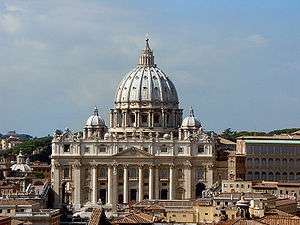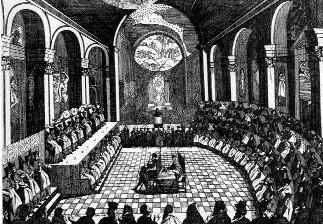Optatam Totius
| Second Vatican Ecumenical Council Concilium Oecumenicum Vaticanum Secundum (Latin) | |
|---|---|
 Saint Peter's Basilica Venue of the Second Vatican Council | |
| Date | 11 October 1962 – 8 December 1965 |
| Accepted by | Catholic Church |
Previous council | First Vatican Council |
| Convoked by | Pope John XXIII |
| President |
Pope John XXIII Pope Paul VI |
| Attendance | up to 2,625[1] |
| Topics | The Church in itself, its sole salvific role as the one, true and complete Christian faith, also in relation to ecumenism among other religions, in relation to the modern world, renewal of consecrated life, liturgical disciplines, etc. |
Documents and statements |
Four Constitutions:
Three Declarations:
Nine Decrees:
|
| Chronological list of ecumenical councils | |
| Part of a series on |
| Ecumenical councils of the Catholic Church |
|---|
 Renaissance depiction of the Council of Trent |
| Antiquity (c. 50 – 451) |
| Early Middle Ages (553–870) |
| High and Late Middle Ages (1122–1517) |
| Modernity (1545–1965) |
|
|
Optatam Totius, the Decree on Priestly Training, is a document which was produced by the Second Vatican Council. Approved by a vote of 2,318 to 3 of the bishops assembled at the council, the decree was promulgated by Pope Paul VI on October 28, 1965. The Latin title means "desired renewal of the whole [Church]". (The full text in English is available from the Holy See's website.)
Contents
The numbers given correspond to the section numbers within the text.
- The Program of Priestly Training to be Undertaken by Each Country (1)
- The Urgent Fostering of Priestly Vocations (2-3)
- The Setting Up of Major Seminaries (4-7)
- The Careful Development of the Spiritual Training (8-12)
- The Revision of Ecclesiastical Studies (13-18)
- The Promotion of Strictly Pastoral Training (19-20)
- Training to be Achieved After the Course of Studies (21)
- Conclusion
Optatam Totius influenced German Roman Catholic theologian Karl Rahner to write his work The Foundation of Christian Faith.
Controversy
The period that followed the promulgation Optatam Totius was marked by a severe drop in the number of priestly vocations in the Western World. Church leaders had argued that age-old secularization was to blame and that it was not directly related to the documents of the Council. Historians have also pointed to the damage caused by the sexual revolution in 1968 and the strong backlash over Humanae vitae. Yet other authors have asserted that the drop in vocations was at least partly deliberate and was part of an attempt to de-clericalize the Church and allow for a more pluralistic clergy.[2]
References
- ↑ Cheney, David M. "Second Vatican Council". Catholic Hierarchy. Retrieved 18 May 2011.
- ↑ COZZENS, Donald B., The Changing Face of the Priesthood, 2000
